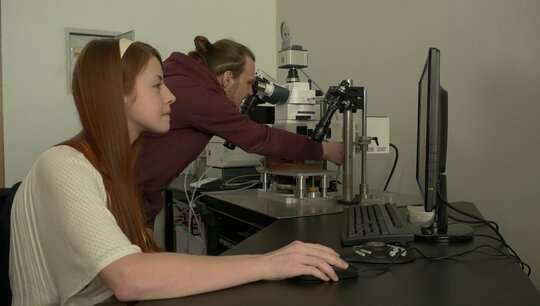Rare copper oxide exhibits unusual magnetic properties and spin-orbit interactions

The scientists of Ural Federal University conducted a study in which they found that one of the copper oxides with a structure of a rare mineral spinel—CuAl2O4—is a material with unusual magnetic properties and structure due to significant spin-orbit interactions.
The scientists described the process and the results of the research in the article published in Physical Review B, the world's largest specialized journal on solid state physics.
Spin-orbit interaction is due to the electromagnetic interaction of the electron spin with the magnetic momentum caused by electron spinning around a nucleus. The phenomenon is essential to 4d and 5d systems, which are based on the elements of the fifth and sixth groups in Mendeleev's periodic table—from yttrium to cadmium and from hafnium to mercury, respectively. CuAl2O4 is a 3d system, because copper belongs to 3d elements (from scandium to zinc in the periodic table) for which spin-orbit interaction is usually not so crucial. However, it turns out that in the case of c CuAl2O4, it is pivotal. The spin-orbit interaction not only brings about the magnetic properties, but also determines the crystal structure of the material.
The point is that the crystal structure of almost all known copper oxides (including both high-temperature Cu-based superconductors and the well-known copper sulphate—CuSO4•5H2O)—is considerably distorted. However, the tetrahedra of oxygen atoms surrounding copper ions in CuAl2O4 remain ideal down to the lowest temperatures. This fact was discovered in 2017 by South Korean and American researchers, but it became possible to explain it only recently, as a result of the research with the participation of Ekaterinburg scientists.
"The distortions in copper oxides are caused by one of the most fundamental physical phenomena, the Jahn-Teller effect. This is, in fact, a very simple phenomenon. Physical systems, like people, do not like uncertainty and try to avoid situations where electrons are unable to occupy a strictly determined level of energy, but have to choose from what is available. It is easy to deprive electrons of this freedom—you only need to move atoms from highly symmetric positions, thereby distorting the crystal lattice," co-author Prof. Sergei Streltsov, Dr. Sci. in Physics and Mathematics, head of the UrFU Laboratory of Electronic and Nuclear Resonance and the Institute of Metal Physics of the Ural Branch of the Russian Academy of Sciences' (IMP UB RAS) Laboratory of Low-Dimensional Spin Systems Theory, explains.
However, it does not work like that in CuAl2O4: spin-orbit interaction interferes. It determines in which orbits electrons spin and what energies they have.
Interestingly, the spin-orbit interaction not only preserves the symmetric lattice in CuAl2O4, but also affects its magnetic properties. Theoretical calculations performed by Sergei Nikolaev (UrFU Academic Department of Theoretical Physics and Applied Mathematics) and Andrei Ignatenko (IMP UB RAS) show that spin-orbit interaction causes spins to twist. As a result, in an ideal CuAl2O4 sample, in extremely low temperatures region, the spins do not line up along one direction, as, for example, in ordinary iron, but must form a so-called "spin spiral."
"The easiest way to describe such magnetic structure is by the example of a chain consisting of spins," Sergei Streltsov says. "If the spins are aligned in parallel, then we get a ferromagnet, in antiparallel (that is, alternating between up and down), an antiferromagnet. And if each spin is gradually deflected at the same angle relative to the previous one, then we get spin spiral. It is this type of magnetic ordering that is expected in a perfect sample of CuAl2O4."
More information: S. A. Nikolaev et al. Realization of the anisotropic compass model on the diamond lattice of Cu2+ in CuAl2O4, Physical Review B (2018). DOI: 10.1103/PhysRevB.98.201106
Journal information: Physical Review B
Provided by Ural Federal University




















